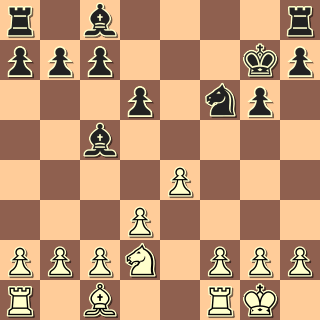In the ongoing RedHotPawn.com Jerome Gambit thematic tournament, there have been some more completed games, from the second round.
SeinfeldFan91 defeated Red House two games to none, to advance to the next round.
SeinfeldFan91 - Red House
Giuoco Piano Jerome Gambit, RedHotPawn.com, 2015
1.e4 e5 2.Nf3 Nc6 3.Bc4 Bc5 4.Bxf7+ Kxf7 5.Nxe5+ Nxe5 6.Qh5 Ke6 7.f4 Nf6 (returning the two sacrificed pieces) 8.Qxe5+ Kf7 9.Qxc5 d6 10.Qb5 (TN according to The Database) Re8 11.d3 Kg8 12.O-O a6 13.Qb3 Kh8 14.Nc3 Rab8 15.f5 h6 16.Be3 Ng4 17.Ba7 Ra8 18.Bd4 Qh4 (a short-lived counter-attack) 19.h3 Ne5 20.Nd5 Qd8 21.f6 gxf6 22.Rxf6 Re6 23.Raf1 Rxf6 24.Rxf6 Kh7 25.Bxe5 dxe5 26.Rf7 Kh8 27.Nf6 Black resigned
Red House - SeinfeldFan91
Giuoco Piano Jerome Gambit, RedHotPawn.com, 2015
1.e4 e5 2.Nf3 Nc6 3.Bc4 Bc5 4.Bxf7+ Kxf7 5.O-O (A "modern" Jerome Gambit variation; in this game White's attack never quite gets going.) Nf6 6.Nc3 d6 7.d3 Rf8 8.h3 Kg8 9.Bg5 Be6 10.Nce2 Qe8 11.c3 Qg6 12.Ng3 Kh8 13.b4 Bb6 14.a4 a6 15.b5 Na5 16.Rb1 axb5 17.axb5 Nd7 18.Bd2 Qxg3 19.d4 Qg6 20.Qe2 Bc4 White Resigned
Swiss Toni defeated Marko Krale two games to none, to advance to the next round.
Marko Krale - Swiss Toni
Giuoco Piano Jerome Gambit, RedHotPawn.com, 2015
1.e4 e5 2.Nf3 Nc6 3.Bc4 Bc5 4.Bxf7+ Kxf7 5.O-O (Another "modern" Jerome) Nf6 6.c3 Nxe4 7.Qe2 d5 8.d3 Nf6 9.Bg5 Bd6 10.Nbd2 h6 11.Bh4 Re8 12.Re1 g5 13.Bg3 Kg8 14.Nb3 Kh7 15.h3 Nh5 16.Bh2 g4 17.hxg4 Bxg4 18.Qe3 Ng7 19.Bg3 Nf5 White Resigned
Swiss Toni - Marko Krale
Giuoco Piano Jerome Gambit, RedHotPawn.com, 2015
1.e4 e5 2.Nf3 Nc6 3.Bc4 Bc5 4.Bxf7+ Kxf7 5.Nxe5 Nxe5 6.Qh5 Ng6 7.Qd5+ Ke8 8.Qxc5 d6 9.Qe3 Nf6 10.d4 Qe7 11.O-O Bd7 (Charlick - Mann, corres, 1881, [1-0, 72] continued 11...Ng4) 12.Nc3 Bc6 13.Bd2 Kf7 14.f4 Nxe4 15.f5 Nf8 16.d5 Bd7 17.Nxe4 h6 18.f6 gxf6 19.Bc3 f5 20.Bxh8 Black resigned
Although Swiss Toni - jecidi and jecidi - Marko Krale from the second round have yet to be completed, round three's match between SeinfeldFan91 and Swiss Toni has begun.

.png)
.png)
.png)
.png)
.png)
.png)

.png)
.png)
.png)
.png)
.png)
.png)
.png)
.png)
.png)
.png)

.png)
.png)
.png)
.png)
.png)
